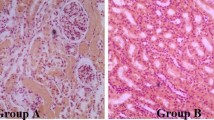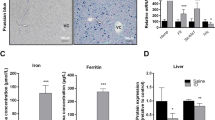Abstract
The response of copper metabolism to dietary copper challenge was investigated in jaundiced rats with elevated plasma concentrations of conjugated bilirubin as a result of impaired canicular transport of bilirubin glucuronides. Control and jaundiced rats were fed purified diets with either normal (64 µmol Cu/kg) or high (640 µmol Cu/kg) concentration of added copper. Copper loading produced a greater increase in hepatic copper concentrations in the jaundiced than in control rats. The greater dietary-copper-induced increase in hepatic copper in the jaundiced rats can be explained by the observed smaller rise in biliary copper excretion and a greater efficiency of dietary copper absorption. In individual rats, there was a positive relationship between hepatic copper concentrations and biliary copper concentrations. It is suggested that not the transport of copper from liver cells to bile but that from plasma to bile is diminished in the jaundiced rats. The elevated plasma copper concentrations in the jaundiced rats may support this suggestion.
Similar content being viewed by others
References
P. L. M. Jansen, W. H. Peters, and W. H. Lamers, Heriditary chronic conjugated hyperbilirubinemia in mutant rats caused by defective hepatic anion transport, Hepatology 5, 573–579 (1985).
F. Kuipers, M. Enserink, R. Havinga, A. B. M. Van der Steen, M. J. Hardonk, J. Fevery, et al. Separate transport systems for biliary secretion of sulfated and unsulfated bile acids in the rat, J. Clin. Invest. 81, 1593–1599 (1988).
R. P. J. Oude Elferink, R. Ottenhoff, W. Liefting, J. De Haan, and P. L. M. Jansen, Hepatobiliary transport of glutathione and gluthathione conjugate in rats with hereditary hyperbilirubinemia, J. Clin. Invest. 84, 476–483 (1989).
R. Houwen, M. Dijkstra, F. Kuipers, E. P. Smit, R. Havinga, and R. J. Vonk, Two pathways for biliary copper excretion in the rat. The role of glutathione, Biochem. Pharmacol. 39, 1039–1044 (1990).
N. Sugawara, Y. R. Lai, and C. Sugawara, Therapeutic effects of tetrathiomolybdate on hepatic dysfunction occurring naturally in Long-Evans Cinnamon (LEC) rats: a bona fide animal model for Wilson’s disease, Res. Commun. Mol. Pathol. Pharmacol. 103, 177–187 (1999).
A. C. Beynen, V. Baumans, A. P. M. G. Bertens, J. W. M. Haas, H. Van Herck, F. R. Stafleu, et al. Identification and clinical examination of jaundiced rats, Z. Versuchstierkd. 32, 1–5 (1989).
M. Dijkstra, F. Kuipers, G. J. Van den Berg, R. Havinga, and R. J. Vonk, Differences in hepatic processing of dietary and intravenously administered copper in rats, Hepatology 26, 962–966 (1997).
National Research Council, Nutrient Requirements of Laboratory Animals, National Academy of Sciences, Washington, DC. (1978).
C. H. Fleck and A. Barth, Influence of xenobiotics on bile flow and bile composition in rats — methodological approach, Exp. Pathol. 39, 175–185 (1990).
F. W. Sunderman, Jr. and S. Nomoto, Measurement of human serum ceruloplasmin by its p-phenylenediamine oxidase activity, Clin. Chem. 16, 903–910 (1970).
C. D. Klaassen, Biliary excretion of metals, Drug Metab. Rev. 5, 165–196 (1976).
P. Farrer and S. P. Mistillis, Absorption of exogenous and endogenous biliary copper in the rat, Nature 213, 291–292 (1967).
C. A. Owen, Jr., Absorption and excretion of Cu64-labeled copper by the rat, Am. J. Physiol. 207, 1203–1206 (1964).
S. Yu, C. E. West, and A. C. Beynen, Increasing intakes of iron reduce status, absorption and biliary excretion of copper in rats, Br. J. Nutr. 71, 887–895 (1994).
S. Yu and A. C. Beynen, High tin intake reduces copper status in rats through inhibition of copper absorption, Br. J. Nutr. 73, 863–869 (1995).
J. Alexander and J. Aaseth, Biliary excretion of copper and zinc in the rat as influenced by diethylmaleate, selenite and diethyldithiocarbamate, Biochem. Pharmacol. 29, 2129–2133 (1980).
Author information
Authors and Affiliations
Rights and permissions
About this article
Cite this article
Yu, S., van der Meer, R. & Beynen, A.C. Excessive hepatic copper accumulation in jaundiced rats fed a high-copper diet. Biol Trace Elem Res 88, 255–269 (2002). https://doi.org/10.1385/BTER:88:3:255
Received:
Revised:
Accepted:
Issue Date:
DOI: https://doi.org/10.1385/BTER:88:3:255




